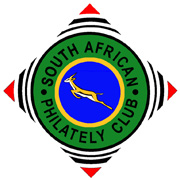Battle of Elandslaagte - 21st October 1899
Quote from Steve on September 7, 2025, 12:08 pmThe two Boer republics of the Orange Free State and the South African Republic (ZAR / Transvaal) declared war on Britain and its Empire on 11th October 1899. The Battle of Elandslaagte took place ten days later, (21 October 1899), during the early stage of the South African War (1899 - 1902) when the Republican Boer forces were invading Natal with one stated aim being to "eat bananas on Durban Beach". It was one of the few decisive victories won by the British Army at this stage of the war when its Northern Natal forces were retreating before of 20,000 Boer invaders, ultimately to be bottled up in Ladysmith for 75 days before being relieved in February 1900.
1899. Photo. Two Scottish soldiers whitewash stones "before the battle, 20th October".
If this is Elandslaagte, the soldiers are from the 2nd Gordon Highlanders.
This photo has been in my possession for some 20 years. I pulled it out of a box of old photos marked 50p each. I probably paid too much! Nevertheless, it is interesting to me as it is almost certainly a scene snapped during the South African War, 1899 ¬ 1902. The comment on its revese "before the battle, 20th October" suggests that this is more than likely the Battle of Elandslaagte in Natal. (I have colourised it with AI, right).
Whitewashed stones were a feature of British Army camps in South Africa, and elsewhere. Both soldiers have whitewash on their hands, the bending soldier has it on his boots. However, for me the best feature of this photo is that the erect soldier is wearing his sun-helmet reversed. This was common practice. As it was intended to prevent sun-burn to the back of the neck, the sun-helmethund over the back of the neck. (These soldiers are 'rooinekke' (Afr. red necks)). This feature of the sun-helmet's design worked well for soldiers who stood erect, shoulder-to-soldier in serried ranks firing volleys at the enemy. The reality of war in South Africa was that the Boer's high-powered rifles could kill at great distances and standing up to such rifle fire was plain stupid. The best solution was to lie down and take cover. Unfortunately, a soldier who did so was prevented by his sun-helmet from raising his head to aim and fire his rifle. When he did the back of his sun-helmet pressed into his upper back. The higher he tried to raise his head, the more the sun-helemet was pushed forward over his eyes. For some, the solution was to wear it back to front. This problem also occurred when bending down, in this case to whitewash stones.
Circa 1903. Postcard. 'Elandslaagte'.
This presumably shows the battlefield and the Boer position on the high ground.The question remains "which Scottish regiment do the Highlanders represent?". The only Scottish regiment at the Battle of Elandslaagte was the 2nd Gordon Highlanders. They attacked the Boer position on October 21st alongside the 1st Devonshire Regiment and the 1st Manchesters, as well as the Imperial Light Horse.
General Jan Kock was in command of a Republican force that included the Johannesburg commando of General Ben Viloen, a lawyer and member of the Second Raad (Parliament) for the Rand, and the volunteer Hollander corps and the German brigade, in all about 800 men. The invaders entered Natal through Botha's Pass at midnight on the 12th of October. For many, their martial adventure was to be brief. Nine days later at Elandslaagte they were defeated in one of the few conventional battles of the war in which Boers suffered the heavier casualties. British losses were 55 dead and 205 wounded whereas Boer losses were 45 dead, 105 wounded and 185 missing or taken prisoner. Ben Viloen escaped but Captain De Witt Hamer, the commander of the Hollander Corps, was captured.
Circa 1985. Postcard. 'Battle of Elandslaagte, Natal, 12 (sic) October 1899'. (Leisure Card / Prizmark Africa).
The 2nd Gordon Highlanders attack Republican forces, many of whom were Hollanders and Irish volunteers.
Is that General Ben Viljoen escaping, right?Boudewijn Gerrit de Witt Hamer was a Hollander who had served as an officer in the Dutch army before sailing for South Africa. He arrived in 1885 and spent time in Natal as the editor of a Dutch language farmer’s newspaper before moving to the ZAR. He was elected member of the Volksraad for Barberton in 1897. When the South African War began to look inevitable the ZAR government approved the formation of a Hollander Corps consisting of two divisions, field and garrison. Captain de Witt Hamer, the Town Clerk of Pretoria, was given command of the field division which consisted of about 150 men. After his capture at Elandslaagte he spent time on HMS Penelope, a prison hulk, in Simonstown and therefter the duration of the war as a POW on St Helena.
After his transfer to St Helena De Witt Harmer made himself useful to the British by acting as a Dutch language censor. He lived in the same house as General Cronje. He returned to SA after the war. To know a bit more about what happened after the British victory at Elandslaagte, click on the link to read about the consequent humiliation of the Siege of Ladysmith.
The two Boer republics of the Orange Free State and the South African Republic (ZAR / Transvaal) declared war on Britain and its Empire on 11th October 1899. The Battle of Elandslaagte took place ten days later, (21 October 1899), during the early stage of the South African War (1899 - 1902) when the Republican Boer forces were invading Natal with one stated aim being to "eat bananas on Durban Beach". It was one of the few decisive victories won by the British Army at this stage of the war when its Northern Natal forces were retreating before of 20,000 Boer invaders, ultimately to be bottled up in Ladysmith for 75 days before being relieved in February 1900.
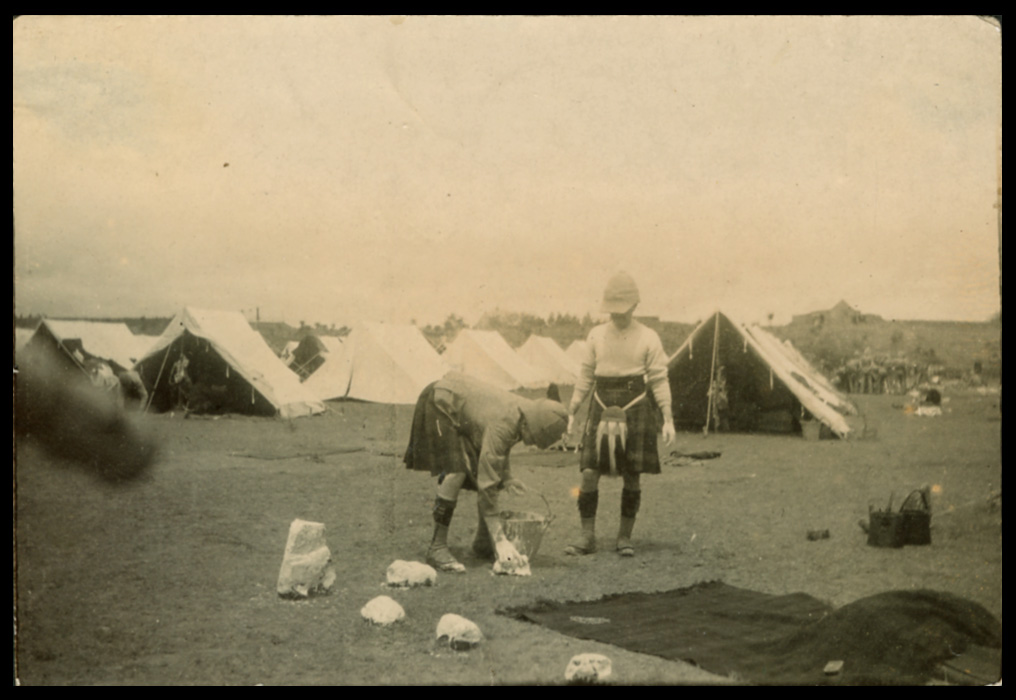
1899. Photo. Two Scottish soldiers whitewash stones "before the battle, 20th October".
If this is Elandslaagte, the soldiers are from the 2nd Gordon Highlanders.
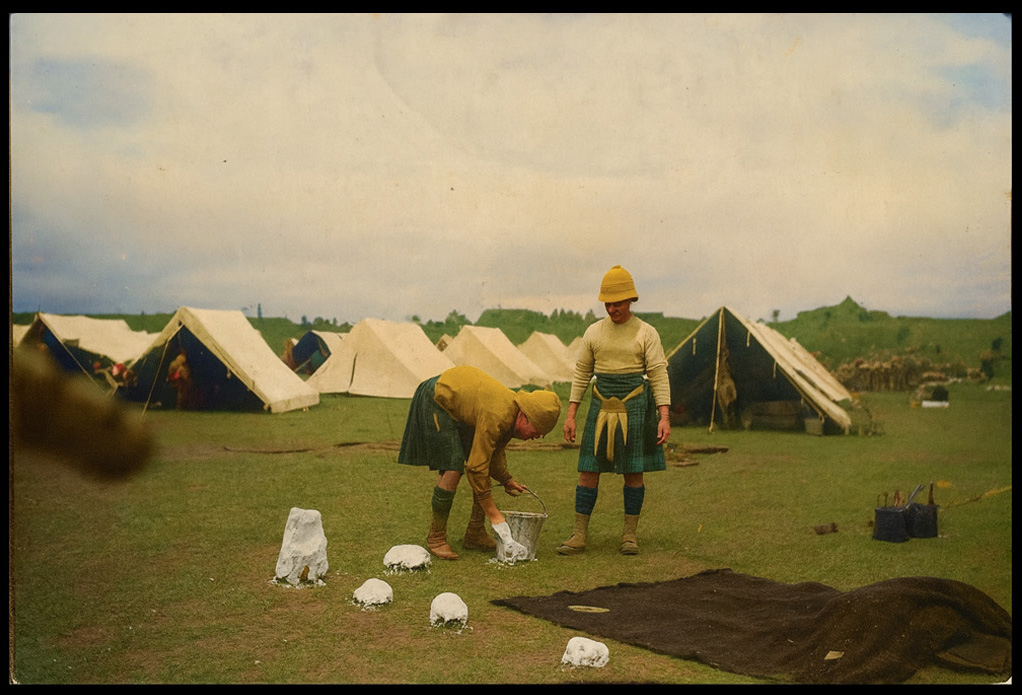 This photo has been in my possession for some 20 years. I pulled it out of a box of old photos marked 50p each. I probably paid too much! Nevertheless, it is interesting to me as it is almost certainly a scene snapped during the South African War, 1899 ¬ 1902. The comment on its revese "before the battle, 20th October" suggests that this is more than likely the Battle of Elandslaagte in Natal. (I have colourised it with AI, right).
This photo has been in my possession for some 20 years. I pulled it out of a box of old photos marked 50p each. I probably paid too much! Nevertheless, it is interesting to me as it is almost certainly a scene snapped during the South African War, 1899 ¬ 1902. The comment on its revese "before the battle, 20th October" suggests that this is more than likely the Battle of Elandslaagte in Natal. (I have colourised it with AI, right).
Whitewashed stones were a feature of British Army camps in South Africa, and elsewhere. Both soldiers have whitewash on their hands, the bending soldier has it on his boots. However, for me the best feature of this photo is that the erect soldier is wearing his sun-helmet reversed. This was common practice. As it was intended to prevent sun-burn to the back of the neck, the sun-helmethund over the back of the neck. (These soldiers are 'rooinekke' (Afr. red necks)). This feature of the sun-helmet's design worked well for soldiers who stood erect, shoulder-to-soldier in serried ranks firing volleys at the enemy. The reality of war in South Africa was that the Boer's high-powered rifles could kill at great distances and standing up to such rifle fire was plain stupid. The best solution was to lie down and take cover. Unfortunately, a soldier who did so was prevented by his sun-helmet from raising his head to aim and fire his rifle. When he did the back of his sun-helmet pressed into his upper back. The higher he tried to raise his head, the more the sun-helemet was pushed forward over his eyes. For some, the solution was to wear it back to front. This problem also occurred when bending down, in this case to whitewash stones.
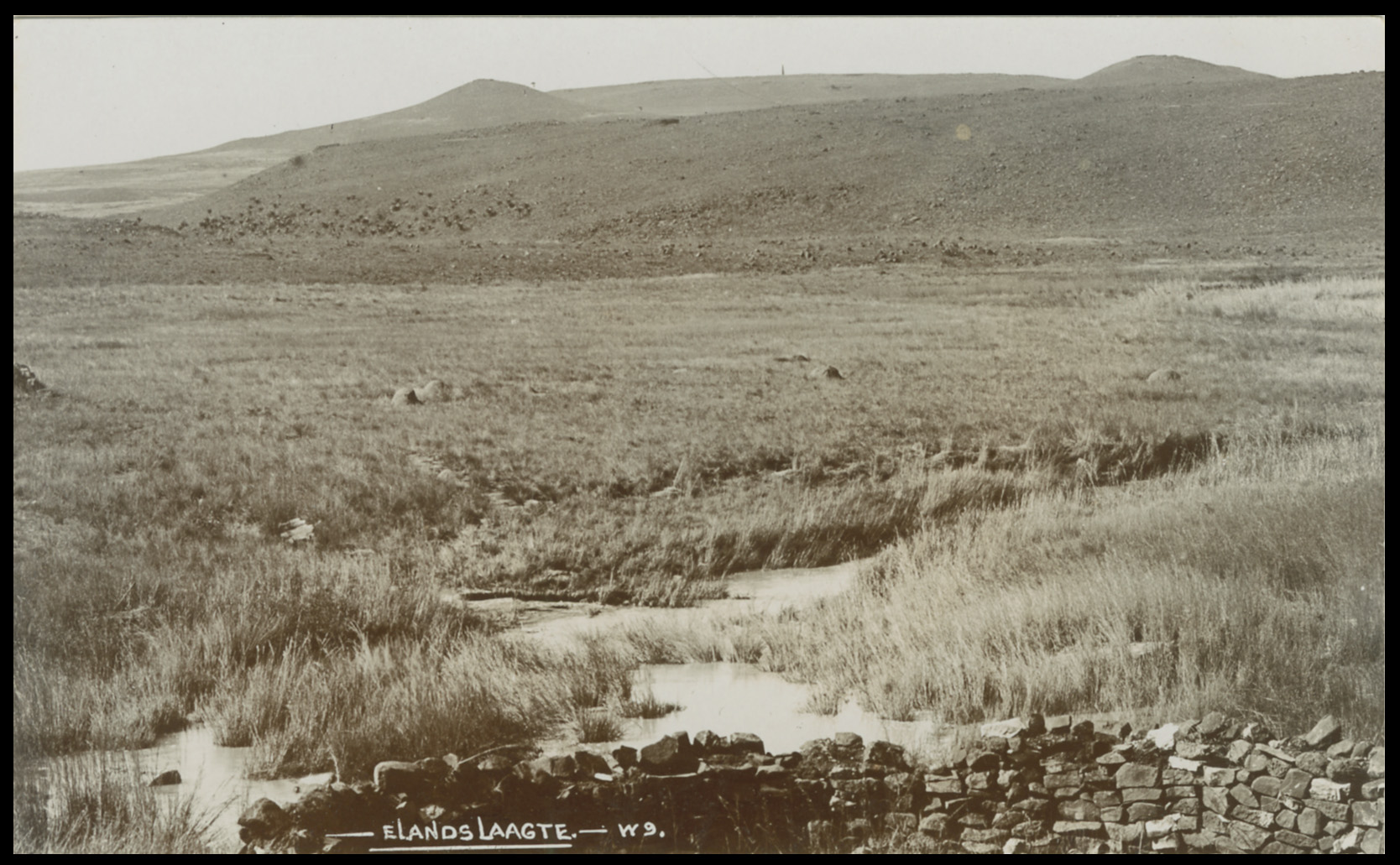
Circa 1903. Postcard. 'Elandslaagte'.
This presumably shows the battlefield and the Boer position on the high ground.
The question remains "which Scottish regiment do the Highlanders represent?". The only Scottish regiment at the Battle of Elandslaagte was the 2nd Gordon Highlanders. They attacked the Boer position on October 21st alongside the 1st Devonshire Regiment and the 1st Manchesters, as well as the Imperial Light Horse.
General Jan Kock was in command of a Republican force that included the Johannesburg commando of General Ben Viloen, a lawyer and member of the Second Raad (Parliament) for the Rand, and the volunteer Hollander corps and the German brigade, in all about 800 men. The invaders entered Natal through Botha's Pass at midnight on the 12th of October. For many, their martial adventure was to be brief. Nine days later at Elandslaagte they were defeated in one of the few conventional battles of the war in which Boers suffered the heavier casualties. British losses were 55 dead and 205 wounded whereas Boer losses were 45 dead, 105 wounded and 185 missing or taken prisoner. Ben Viloen escaped but Captain De Witt Hamer, the commander of the Hollander Corps, was captured.
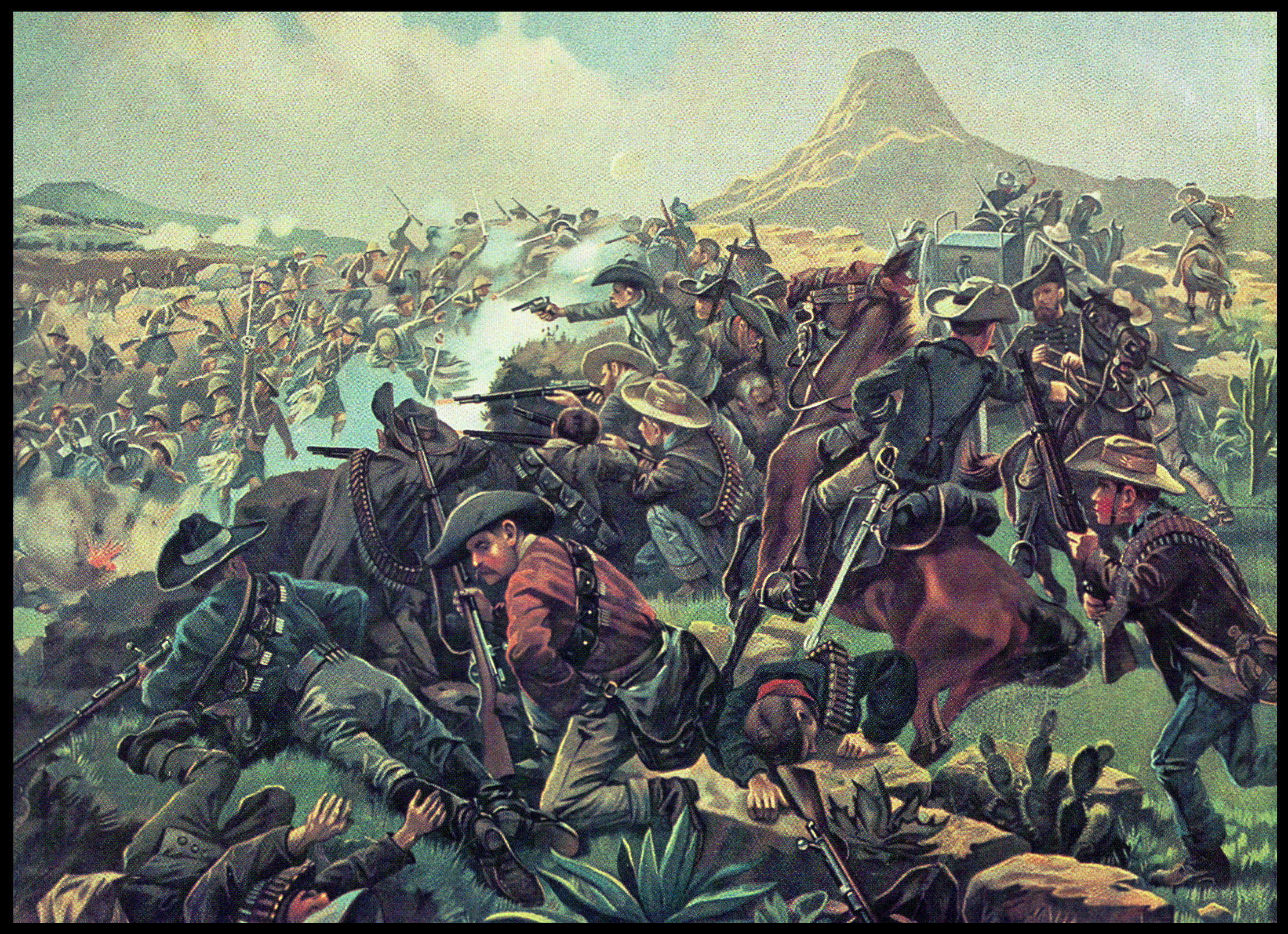
Circa 1985. Postcard. 'Battle of Elandslaagte, Natal, 12 (sic) October 1899'. (Leisure Card / Prizmark Africa).
The 2nd Gordon Highlanders attack Republican forces, many of whom were Hollanders and Irish volunteers.
Is that General Ben Viljoen escaping, right?
Boudewijn Gerrit de Witt Hamer was a Hollander who had served as an officer in the Dutch army before sailing for South Africa. He arrived in 1885 and spent time in Natal as the editor of a Dutch language farmer’s newspaper before moving to the ZAR. He was elected member of the Volksraad for Barberton in 1897. When the South African War began to look inevitable the ZAR government approved the formation of a Hollander Corps consisting of two divisions, field and garrison. Captain de Witt Hamer, the Town Clerk of Pretoria, was given command of the field division which consisted of about 150 men. After his capture at Elandslaagte he spent time on HMS Penelope, a prison hulk, in Simonstown and therefter the duration of the war as a POW on St Helena.
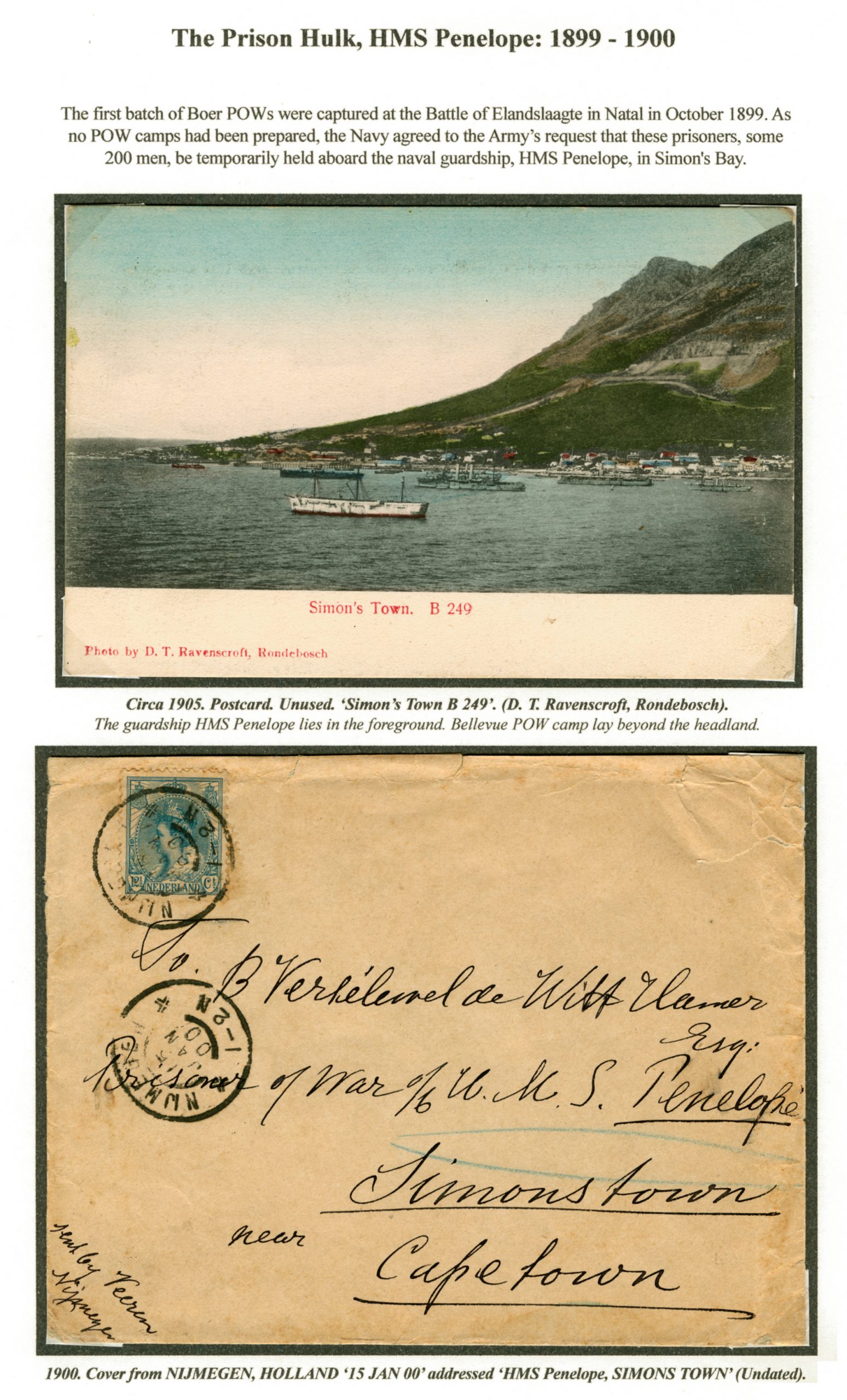
After his transfer to St Helena De Witt Harmer made himself useful to the British by acting as a Dutch language censor. He lived in the same house as General Cronje. He returned to SA after the war. To know a bit more about what happened after the British victory at Elandslaagte, click on the link to read about the consequent humiliation of the Siege of Ladysmith.
